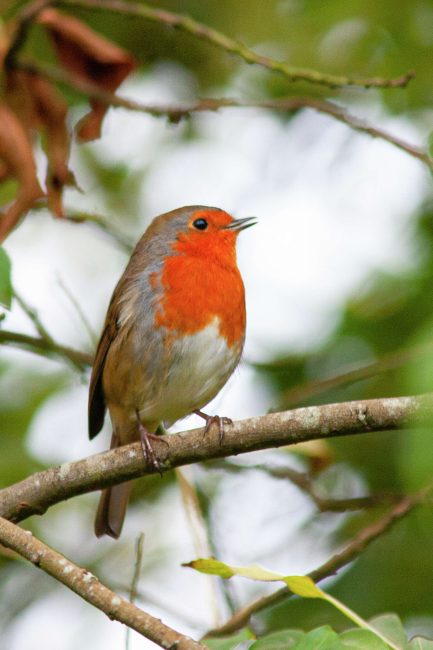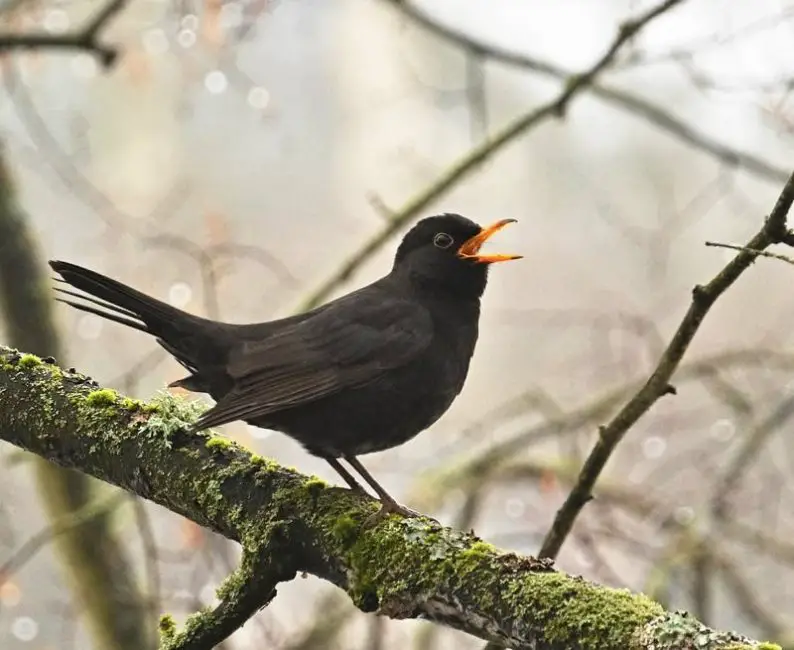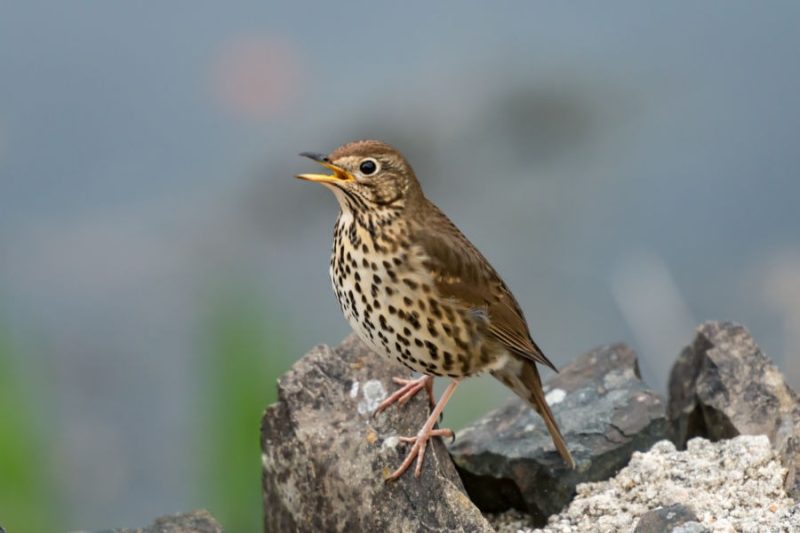The voices of birds often define the essence of a landscape. Among the most beloved and recognizable songbirds are those of the genus Turdus, whose melodies fill forests, gardens, and meadows across North America and Europe. This article compares the songs of three emblematic members of this group: the American Robin (Turdus migratorius), the Common Blackbird (Turdus merula), and the Song Thrush (Turdus philomelos). Though they share a common ancestry, their songs reveal subtle and profound differences shaped by ecology, behavior, and evolution. Understanding these distinctions offers insight into the roles these birds play in their ecosystems and how they communicate through sound.

The Vocal Signatures of Turdus Species
American Robin (Turdus migratorius)
The American Robin is a common sight across North America and is equally known for its musical voice. Its song consists of short, clear phrases, often described as “cheerily, cheer-up, cheerio.” Each phrase is separated by a brief pause, and the bird often sings from a high perch at dawn.
The robin’s song is relatively simple in structure—typically 2–3 syllables repeated in sequence. However, its strength lies in tone and rhythm, which remain remarkably consistent. In urban areas, robins have been observed to shift their singing time earlier in the morning to avoid noise pollution.
Common Blackbird (Turdus merula)

Native to Europe and parts of Asia and North Africa, the Common Blackbird is famous for its flute-like, mellow, and richly modulated song. Each blackbird develops a unique song with elaborate phrasing, which may include whistles, trills, and warbles. Unlike the robin, the blackbird’s song is often more improvisational, offering longer and more complex vocalizations.
Its song is delivered primarily from elevated song posts such as rooftops or tree branches, usually at dawn and dusk. Blackbirds in urban areas have been shown to sing louder and at higher pitches to overcome low-frequency background noise, demonstrating remarkable acoustic plasticity.
Song Thrush (Turdus philomelos)

As its name implies, the Song Thrush is perhaps the most vocally distinctive of the three. Found throughout Europe and parts of Asia, the Song Thrush is noted for its repetitive triplet-like structure. It sings short musical phrases, each repeated two to four times before moving on to the next, giving it a rhythmic and almost mechanical quality.
Unlike the improvisational blackbird or the measured robin, the Song Thrush emphasizes repetition, which increases signal clarity in wooded habitats where sound reverberation and absorption are greater. Its song is also notable for incorporating mimicry of other bird species and even non-bird sounds like machinery.
Shared Traits in Turdus Vocalization
Although the American Robin (Turdus migratorius), the Common Blackbird (Turdus merula), and the Song Thrush (Turdus philomelos) inhabit different continents and environments, their vocal behaviors reveal deep evolutionary and neurological similarities—hallmarks of their shared ancestry within the Turdus genus.
One notable shared trait is diurnal singing, with peak vocal activity occurring during the early morning (dawn chorus) and late afternoon (dusk chorus). This timing is not random. Singing during these quieter hours offers acoustic advantages—fewer environmental noises and more stable air density allow songs to carry farther. In all three species, males dominate these choruses, energetically proclaiming territory and reproductive readiness at times when rivals and potential mates are most likely to hear them.
Equally important is the fact that these songs are not genetically hardwired but learned. Young robins, blackbirds, and thrushes undergo a sensitive period during which they must be exposed to adult song models. Without such exposure, their adult songs are often incomplete or abnormal. This process of auditory learning and vocal practice, known as vocal ontogeny, mirrors the way humans acquire language. The presence of this learned component in all three species suggests that vocal flexibility provides an evolutionary advantage—enabling males to localize their dialects, adjust song features to environmental conditions, and potentially signal individual quality.
Functionally, song serves the same essential roles across these Turdus species: to defend territory, attract mates, and mediate social interactions with neighbors and rivals. A robin’s lilting phrases, a blackbird’s fluty improvisations, and a song thrush’s emphatic repetitions may sound distinct, but all carry coded messages. Song structure can convey information about the singer’s age, health, and dominance status. Even minor variations in phrasing or delivery may signal aggression, submission, or courtship.
Underpinning this shared behavior is a neural architecture that is remarkably conserved across all three species. Key brain regions involved in song learning and production include the High Vocal Center (HVC) and the Robust Nucleus of the Arcopallium (RA). These regions interact to process memorized song templates, coordinate motor output for vocalization, and adapt songs over time. Studies have shown that the size and complexity of these song nuclei can vary with singing experience and season, indicating plasticity that aligns with the birds’ behavioral needs.
Collectively, these vocal traits—diurnal timing, learned song acquisition, multifunctional use, and shared neural mechanisms—underscore a common evolutionary origin within the Turdus lineage. More than mere coincidence, this vocal convergence highlights the pivotal role of song as a central communicative tool, finely tuned by both genetics and environment to serve survival and reproductive success.
Comparative Analysis: Vocal and Ecological Differences
Feature |
American Robin (T. migratorius) |
Common Blackbird (T. merula) |
Song Thrush (T. philomelos) |
|---|---|---|---|
Song Structure |
Repetitive 2–3 note phrases, loud and clear |
Melodic, flute-like with improvisation |
Highly structured, repeated triplets |
Syllable Repetition |
Rarely repeats same phrase |
Improvises with variation |
Repeats phrases 2–4 times |
Tone and Mood |
Cheerful, rising notes |
Rich, mellow, introspective |
Bright and emphatic, rhythmic |
Learning Period |
Seasonal, early spring |
Prolonged, even post-fledging |
Early, consistent learning and mimicry |
Mimicry |
Rare or absent |
Occasional |
Frequent and diverse |
Urban Adaptation |
High |
Very high |
Moderate |
Habitat Acoustics and Song Adaptation
The vocalizations of the American Robin, Common Blackbird, and Song Thrush are not just shaped by evolutionary history—they are actively sculpted by the acoustic challenges of the habitats they occupy. Each species has developed song structures and delivery strategies finely tuned to maximize communication efficiency in its respective environment. This phenomenon, known as acoustic adaptation, ensures that important messages—territorial claims, mating calls, and warnings—reach their intended recipients clearly, despite environmental noise or interference.
American Robins typically inhabit open landscapes, including forest edges, suburban lawns, agricultural fields, and parks. These environments present fewer physical obstructions, allowing sound waves to travel long distances with minimal degradation. In response, robins produce short, clear, and melodically simple phrases, often separated by pauses. These punchy, whistle-like notes carry efficiently through open air, minimizing echo and distortion. The clarity of robin songs ensures they remain audible and identifiable across expansive territories, where rivals or mates may be spread out over long distances.
Common Blackbirds display exceptional vocal flexibility, reflective of their occupancy across diverse habitats, from dense woodlands to bustling cities. Their songs feature rich harmonics, slurred notes, and complex modulations, allowing them to adapt to a variety of background conditions. In urban settings, where low-frequency noise from traffic can mask quieter sounds, blackbirds have been observed singing at higher pitches and louder volumes—a clear example of urban song plasticity. In woodland environments, their intricate phrasing and tonal variety help maintain clarity as sound navigates around trees and underbrush. This dual adaptation reflects their generalist nature and ability to thrive in acoustically complex environments.
Song Thrushes, by contrast, specialize in dense, vegetated habitats, such as thickets, hedgerows, and mature forests. These settings pose unique challenges to sound transmission: thick foliage scatters and absorbs sound energy, particularly rapid or low-amplitude sounds. To counteract this, song thrushes employ repetition and strong phrasing—hallmarks of their vocal style. Each musical unit is typically repeated two to four times before moving to the next, a pattern that enhances signal redundancy. This repetition ensures that at least part of the message survives degradation by vegetation, making the signal recognizable even at a distance or through acoustic clutter. Additionally, the tonal contrasts within their song phrases help distinguish their calls from ambient noise like rustling leaves or other birds.
These acoustic adaptations are not fixed; they demonstrate behavioral plasticity and local fine-tuning. For example, individual blackbirds may adjust their phrasing depending on whether they are in a quiet park or near a busy road. Similarly, robins may alter volume or tempo during territorial disputes or dawn chorus competitions. This ability to modulate vocal performance based on local acoustic conditions underscores the importance of environmental feedback in shaping avian communication strategies.
Ultimately, the interplay between habitat structure and vocal design across the Turdus species reveals not only their cognitive and neurological sophistication but also the remarkable ways in which songbirds negotiate their sonic landscapes. The result is a set of vocal styles that, while differing in form, each achieve the same goal: to cut through the environmental noise and be heard, understood, and remembered.
Neurological and Hormonal Basis for Song
At the heart of song production in American Robins, Common Blackbirds, and Song Thrushes lies a finely tuned interplay between brain architecture and hormonal cycles. These birds don’t simply sing by instinct—they rely on specialized neural circuits and endocrine cues that govern the learning, memory, timing, and social function of their songs. This integration of neurobiology and endocrinology reflects the evolutionary sophistication behind avian vocal behavior.
Central to song production in all three species are two key forebrain structures: the HVC (high vocal center) and the RA (robust nucleus of the arcopallium). These nuclei are part of a larger interconnected system known as the song control system, which also includes the Area X, LMAN (lateral magnocellular nucleus of the anterior nidopallium), and other regions involved in motor learning and auditory feedback. The HVC is responsible for encoding learned song sequences and coordinating timing, while the RA transforms these signals into motor commands that control the syrinx—the bird’s vocal organ.
What makes this system dynamic is its seasonal plasticity. During the breeding season, both the HVC and RA enlarge significantly, a phenomenon driven by rising testosterone levels in males. This hormonal surge stimulates neurogenesis (the birth of new neurons), synaptic remodeling, and increased gene expression related to song production. In effect, the bird’s brain becomes more “musically active” during this period, optimizing its ability to perform complex, high-effort vocalizations.
These neurological adaptations support several crucial song functions:
-
Song learning and memory consolidation: Young birds store adult models in the HVC and refine their own versions through auditory feedback and practice.
-
Temporal and rhythmic control: The precise timing of note onset and phrasing is orchestrated by HVC-RA pathways, allowing for species-specific cadences and stylistic signatures.
-
Social recognition: Pattern-matching mechanisms in auditory and associative brain regions help individuals recognize neighbors, mates, and rivals—essential for territory stability and pair bonding.
Beyond neural control, hormonal cycles add a behavioral layer of regulation. Testosterone levels rise in spring and early summer, triggering not just the physical growth of brain nuclei, but also behavioral changes in vocal output. Males with higher circulating testosterone levels sing more frequently, with greater intensity, and may exhibit increased vocal complexity or aggression—a signal to both rivals and potential mates of their vitality and reproductive fitness.
Interestingly, the sensitivity of the song system to hormones varies not only across species but also across individuals and regions. In urban environments, for instance, blackbirds have been observed to maintain elevated testosterone levels for longer durations, possibly due to extended breeding seasons or social pressures, which in turn sustains their vocal activity well beyond rural counterparts.
In summary, the song behavior of Turdus species emerges from a dynamic biological framework, where neural structure provides the foundation, and hormonal shifts act as modulators of performance. This complex system allows the birds to time their songs strategically, adjust them to social and environmental demands, and maintain vocal precision—an essential tool for survival and reproduction in a competitive acoustic world.
Cultural and Evolutionary Implications
Bird song acts as both a biological signal and a cultural trait. In robins, females may select mates based on consistency and timing. In blackbirds, song diversity may serve as a proxy for cognitive fitness. In song thrushes, vocal mimicry and phrase repetition may indicate experience or territory quality.
Over evolutionary time, differing ecological niches and selection pressures have resulted in divergent song styles:
- The robin has emphasized clarity and rhythm.
- The blackbird has evolved variation and expressiveness.
- The song thrush has refined structure and redundancy.
These differences highlight the role of sexual selection, habitat acoustics, and social communication in shaping bird song.
Conclusion
The songs of the American Robin, Common Blackbird, and Song Thrush each offer a unique auditory experience that reflects their ecological context, neurological makeup, and evolutionary history. Together, they demonstrate the diversity of avian vocal strategies within a single genus. From the rhythmic triplets of the Song Thrush to the flute-like musings of the Blackbird and the clear, measured cheer of the Robin, the genus Turdus embodies the full spectrum of birdsong.
As these birds continue to adapt to changing landscapes and urban environments, their songs not only endure—but evolve. Studying their voices allows us to better understand how nature communicates, adapts, and survives through sound.






